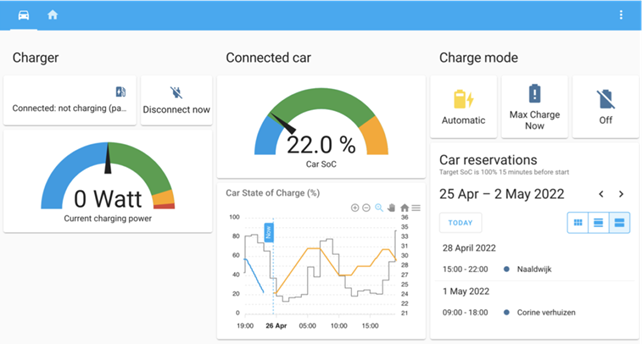FlexMeasures: The Open Source Toolkit for Smart Energy Flexibility Services

The energy sector is undergoing a major transformation, with new challenges and opportunities arising from the rise of renewable energy sources and the electrification of everything from heating to transportation. One of the most pressing challenges is managing the increasing demand for electricity while ensuring grid stability and minimizing costs. Additionally, the intermittent nature of renewable energy sources such as solar and wind power makes it difficult to match supply with demand, leading to potential grid imbalances.
Energy flexibility is a solution to these challenges. It refers to the ability to adjust energy consumption and production in response to changes in supply, demand, or prices. This can be achieved through a variety of technologies and strategies, such as smart appliances, energy storage systems, and demand response programs.
FlexMeasures is an open source EMS platform for optimizing energy flexibility, built for innovative startups and digitally-enabled energy service companies (ESCOs).
Think of it as the “Lego Mindstorms” of smart energy planning – combining out-of-the-box functionality (like the algorithms but also UIs and APIs) with modularity, so your digital energy service has the ability for smart orchestration of behind-the-meter assets.
Developed by Seita Energy Flexibility, a Dutch-German startup and contributed to LF Energy, FlexMeasures is already being adopted by smart energy startups worldwide. These startups are leveraging its versatile, developer-friendly tools to build impactful solutions for energy planning and optimization, often using FlexMeasures as the basis for their EMS design.
The Opportunity of Energy Flexibility
A device is energy-flexible when its consumption can be shifted in time. For example, charging an EV later or creating heat ahead of time to take advantage of lower prices, lower CO2 emissions, or peak demand avoidance. These goals are valuable to asset owners and utilities. The behind-the-meter segment is growing rapidly, and grid congestion and market price volatility are also increasing.
FlexMeasures can help orchestrate a wide range of use cases, including:
- Domestic buildings with heat pumps and EVs, optimized to lower energy costs under a dynamic tariff
- Neighborhoods with shared facilities and grid capacity constraints
- Office buildings with multiple EVs
- SME buildings with light industrial processes and solar roofs
- Large industrial plants with heat buffering systems

Figure 1: Behind-the-meter orchestration, as imagined by AI
Now there are startups in smart charging and smart heating popping up, all of them re-inventing the smart orchestrating part, which essentially boils down to that energy flexibility problem: When should which device do what it needs to do?
- Why not re-use a common and open technology for this smart scheduling, even share in developing it, making room for these startups to focus on their customer-facing value-add? Startups and ESCOs could save drastically on theirR&D and engineering costs, as a complex aspect is now easier. It’s important to note that the orchestration challenge behind the meter structurally does not differ very much across the world. Electrification of transport (e-SUVs or e-scooters) and temperature regulation (heating or cooling) happens everywhere, and so does the stress this causes on electricity grids.
- Talking about complexity, if you recall the use cases above, it is obvious that owners aim to optimize all devices together, orchestrating them as one. They only have one energy contract, after all. Smart charging and smart heating/cooling combined (also called “sector coupling”), adding a battery to the mix, adding dynamic tariffs and congestion limits. This orchestration problem is more complex than many startups realize at first.
Of course, the customer is different per startup or ESCO, and per region. They should concentrate on designing this “last mile” towards local culture, customer expectations and conditions of hardware and markets. This leads to a unique UX, custom device integrations and so on. In principle, the logic of orchestrating devices can be served by the same smart back-end. Why not use an open source one?

Figure 2: Some screenshots of the FlexMeasures UI
FlexMeasures in Action
Here are two testimonials of startups that have implemented FlexMeasures to use smart orchestration in their own innovative energy services:
Thiink Inc (U.S.)
“FlexMeasures is a great way to start creating an energy management system solution. You can easily simulate and test without having all the energy hardware. The built-in UI makes it easy to visualize what is going on. Using the terminology of the USEF framework is also good and helps people acquire a terminology that helps with understanding of the European energy markets.”
— Ragnar Edholm (Senior Vice President of Engineering), Thiink Inc
iRasus Technologies (India)
“In India, we currently see three use cases for battery energy storage systems (BESS): round-the-clock solar power, islanding and frequency regulation in a grid, and diesel generator replacement. We aim to use FlexMeasures for the steering logic that will connect the monitoring and the control. For this logic, price-based scheduling and forecasting as an ancillary feature are important to us. In India, any optimisation tool needs to be better than a guy with a full-time job trying to do the same using Excel, because India has loads of such people at affordable salaries for employers. What’s exciting here is the option to have interoperability and customisation. And that’s where FlexMeasures can fit in.”
— Aniruth Ramesh (CTO), iRasus Technologies
FlexMeasures Features
FlexMeasures not only plans energy flows, it also supports building of web-apps. It starts as a basis for building your smart energy services, then helps you extend with custom features and finally supports scaling up. Here is a high-level list of features:
- Cloud Energy Management System (API-first)
- Built-in algorithms (e.g., vehicle-to-grid, batteries, processes)
- Use cases for heating, cooling, charging and beyond
- Plugin/extensibility options (open source examples: OpenWeatherMap, ENTSO-E data platform)
- White-label solutions for branding the in-built UI
- Support for servicing customers: connectivity status pages, audit logs, monitoring
- Scalability: task queuing for distribution across CPUs
- Self-service: customers/partners can adapt device settings and graphs in the UI
FlexMeasures fits into the modern energy stack as a “cloud EMS”. As devices become digitized and connectable, sites require some “on-site EMS” to control local flows – usually hardware with device integrations and business rules. FlexMeasures serves as a planning system which combines more information than is available locally, and plans the optimal schedules for the site.

Figure 3: Layers of a modern energy site
FlexMeasures features are constantly improved, but the two biggest additions on the roadmap are an algorithm dedicated to Virtual Power Plant settings (VPP) and adding support for open energy flexibility standards, like S2 and OpenADR, so FlexMeasures can become a tool within an open technology eco-system.
Real World Domestic Energy Management Example: V2G App in The Netherlands
Seita has used FlexMeasures to orchestrate the batteries of more than ten Nissan Leafs, each in their own building. The cars operate in a vehicle-to-grid (V2G) mode, so apart from smart charging (taking advantage of longer parking times and local PV), the orchestration can also plan discharging back to the grid using dynamic energy tariffs. The local control (on-site EMS) has also been co-developed by Seita for this specific service. The cars charge and discharge schedules take into account user-defined set points (e.g. for longer rides) and keep the battery within user-defined limits (e.g. 20%-80% state of charge) and otherwise optimize economic results from the dynamic tariff (spot market prices).

Figure 4: The V2GLiberty dashboard, with smart charging schedules powered by FlexMeasures
As of Q1 2025, we have collected around three years of operational data (Q4 2022) and we see that less than 0.01€ has been paid for each driven kilometer. Yearly savings in charging costs per car between 1k€ and 1.5K€ are observed, confirming what other studies predict. Read more about this project – which includes open source code based on HomeAssistant – for automating V2G at https://v2g-liberty.eu/.
To get started with FlexMeasures and join the ecosystem:
- Review documentation including numerous tutorials and explanations at https://flexmeasures.io
- For developers, there are points to work from after the tutorials: Load data using CSV loaders and play with the Docker compose stack. Also, write your own plugin by reading the documentation section and see this 2024 FOSDEM talk
- Join the open source community and ask questions or contribute: There is a Slack channel, a mailing list, and Technical Steering Committee meetings are open to discuss ongoing features and ask questions.
Why Open Source for Energy Flexibility?
Seita Energy Flexibility, the Dutch-German startup behind FlexMeasures, began their journey to tackle real-world energy challenges with smarter, more adaptable solutions in 2018. Recognizing the broader potential of their platform, Seita chose to open source FlexMeasures under LF Energy. This decision was driven by a commitment to maximizing their clean-tech impact, and to create a win-win innovation train fostering collaboration. Today Seita consists of a team of 10 people and offers scenario simulations and real-time cloud SaaS based on FlexMeasures.